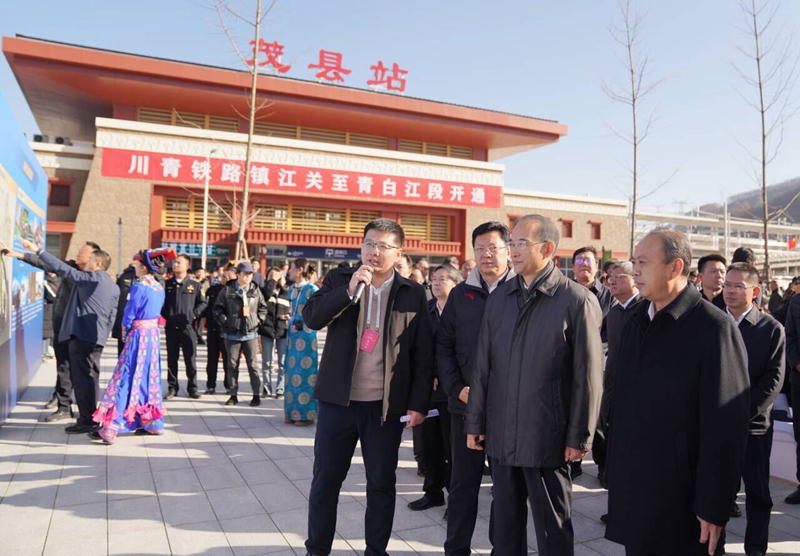
On the morning of November 28, the launching ceremony of the Zhenjiangguan-Qingbaijiang section of the Sichuan-Qinghai Railway was held in the square in front of Maoxian Station along the Sichuan-Qinghai Railway. At about 10:45 a.m., Huang Qiang, Deputy Secretary of the CPC Sichuan Provincial Committee and Governor of the People's Government of Sichuan Province, announced that the Zhenjiangguan-Qingbaijiang section of the Sichuan-Qinghai Railway was open for operation.
At 11:06, the first C6008 train slowly departed from Maoxian Station carrying passengers who wanted to experience the test ride. It arrived at Chengdu East Railway Station 55 minutes later, shortening the mileage by more than two hours. This marks the arrival of the first railway in northwest Sichuan, and Aba Tibetan and Qiang Autonomous Prefecture has entered the era of high-speed trains.
The Sichuan-Qinghai Railway is an integral part of China's "eight vertical and eight horizontal” high-speed railways from Lanzhou City, Xining City to Guangzhou City, and its status in the road network is very important. The line starts from Chengdu East Railway Station and connects to Xining Railway Station in Qinghai Province. The main line is about 836 kilometers long, with a design speed of 200 kilometers per hour. The entire line is constructed in sections. The section from Chengdu East Railway Station to Qingbaijiang East Railway Station and the section from Haidong West Railway Station to Xining Railway Station in Qinghai Province have been put into operation. The section opened this time starts from Zhenjiangguan Railway Station in Songpan County, passes through several stations including Diexi, Maoxian, Anzhou, Mianzhu South, Shifang West and Sanxingdui, and connects to Qingbaijiang East Railway Station. The main line is 206 kilometers long. This section is located in the alpine and gorge area where Chengdu Plain transitions to the eastern edge of the Qinghai-Tibet Plateau, with an altitude difference of more than 2,000 meters. It passes through mountain ranges such as the Longmen Mountains, Minshan Mountains and West Qinling Mountains, and crosses three major river systems, namely the Fujiang River, Minjiang River and Jialing River. The project was commenced in 2011 and was finally completed after 12 years of hard work. It is expected that the Zhenjiangguan-Huangshengguan section will be opened in 2024, when the railway will reach Songpan Railway Station and Huanglongjiuzhai Railway Station. After the entire line is completed and opened, the travel time from Chengdu to Xining is estimated to be shortened to 4.5 hours.

Before the launching ceremony, Huang Qiang listened to the reports on the planning and construction of the Sichuan-Qinghai Railway, the remaining construction of the Desheng Tunnel, the development of "all-for-one" tourism in Aba Tibetan and Qiang Autonomous Prefecture, and the implementation of the strategy of building a prefecture with great transport strength. He pointed out that the Sichuan-Qinghai Railway passes through the main areas where the Central Red Army "marched through snowy mountains and arid grasslands" during the Long March, and also crosses the Giant Panda National Park and the Ruoergai National Park. It connects famous scenic spots such as the Jiuzhaigou–Huanglong Scenic Area, Hongyuan Grand Grasslands and the first bay of the Yellow River, as well as the Lanzhou-Xining city cluster in northwest China and the Chengdu-Chongqing economic circle in southwest China. In this case, the railway is of special and important political, ecological and economic significance. It will vigorously carry forward the spirit of the Long March, inherit the red gene, build a solid ecological barrier in the upper reaches of the Yangtze and Yellow Rivers, facilitate extensive exchanges and integration among all ethnic groups, and promote the high-quality development and common prosperity in northwest Sichuan. We should adhere to the principle of putting safety and quality first, intensify our efforts in the construction of the Desheng Tunnel, promote the opening of the Zhenjiangguan-Huangshengguan section next year, and make efforts to accelerate the construction progress of the remaining sections, ensuring that people of all ethnic groups in northwest Sichuan can enjoy the convenience and benefits brought by the railway as soon as possible. Officials of the Aba Tibetan and Qiang Autonomous Prefecture should seize the opportunity of the railway's operation, focus on improving the level of tourism services and reception, vigorously develop medium and high-end cultural tourism products, and accelerate the transformation of lucid waters and lush mountains, as well as glaciers and snowy mountains, into invaluable assets.
Liu Ping, Deputy Director of the Standing Committee of Sichuan Provincial People's Congress and Secretary of the CPC Committee of the Aba Tibetan and Qiang Autonomous Prefecture, delivered a speech. Fu Guocheng, General Manager of the Chengdu-Lanzhou Railway Co., Ltd., introduced the construction progress of the Chengdu-Huangshengguan section of the Sichuan-Qinghai Railway. Heads of relevant provincial departments and cities (autonomous prefectures), along with representatives of the construction organizations of the Sichuan-Qinghai Railway, attended the event.
Hosted by: General Office of the People's Government of Sichuan Province
Website Operation and Maintenance: China Telecom Sichuan Branch
Website Identification Code: 5100000062 Sichuan ICP No. 13001288
Sichuan Computer Information Network and Internet Security Record No. 51010402000507